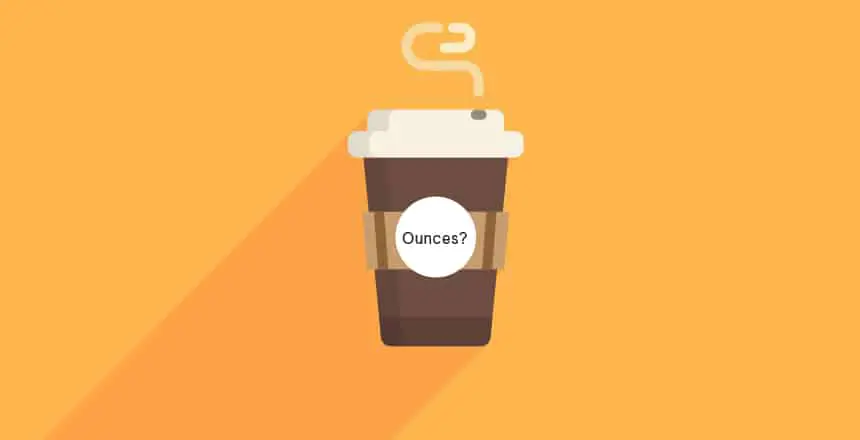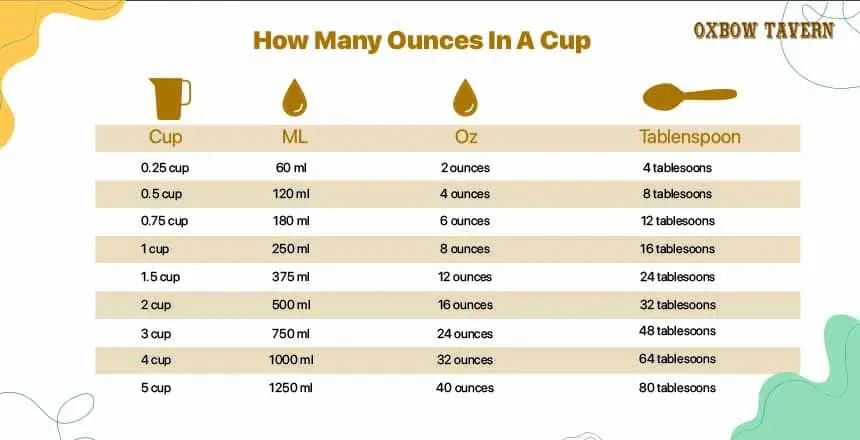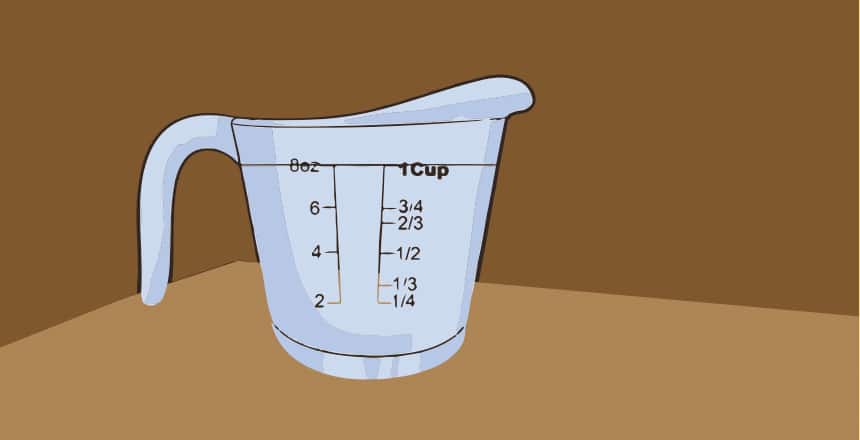If you’re a baking enthusiast or simply trying to navigate the world of measurements, you might wonder how many ounces are in a cup. Determining dry and liquid servings can often be tricky, but don’t stress – this article is here to help!
We’ll break it down so that anyone can understand exactly what constitutes one cup and how much fluid each measurement equates to in terms of ounce volume. Keep reading for helpful tips on how many ounces are in a cup and more!
Related:
- How Many Ml In 8 Oz
- How Many Cups Are In 500ml
- How Many Oz In 2 Liters
- How Many Oz Are in A Half Gallon
Contents
- What is Ounce?
- How Many Ounces In A Cup?
- How to Convert From Ounces to Cups
- What Is the Difference Between Liquid and Dry Measurements?
- Cup for Measuring Liquids
- Cup for Measuring Dry ingredients
- Should I Use Measuring Cups or Scales?
- FAQs
- Does 2 Tablespoons Equal 1 Ounce?
- How Many Ounces in a Cup of Water?
- How Many Ounces Are in a Cup of Sugar?
- How Many Ounces Are in a Cup of Flour?
- How Many Ounces Are in a Cup of Cheese?
- How Many Ounces Are in a Cup of Butter?
- How Many Ounces Are in a Cup of Rice?
- How Many Ounces in a Pound?
- How Many Ounces in a Gallon?
- How Many Ounces are in a Half of A Cup?
- Conclusion
What is Ounce?

Ounce (Oz) is a unit of weight, mass, or volume primarily used in the United States’ customary and imperial systems. In terms of measurement, 1 oz = 28.35 g (grams) or 0.029 kg (kilograms). In the US, the most common ounces are liquid ounces and dry ounces – with each having its own separate measurements.
In general, liquid ounce measurements are used to calculate liquid ingredients, while dry ounce measurements are typically used for non-liquid items such as baking ingredients. Now that you know what an ounce is, let’s figure out how many ounces in a cup!
How Many Ounces In A Cup?
The answer to this question depends on what you’re measuring, as the measurements for a cup of liquid and a cup of dry items differ.
How Many Fluid Ounces in a Cups?
Liquids, for example, milk, water, oil, and juice are measured in fluid ounces (fl oz). So if you want to know how many ounces in a cup for liquid measurements, the answer is 8 fluid ounces per cup, in another word, 1 cup = 8 fl oz.
This formulation is the same for all liquid measurements, regardless of whether you’re measuring a hot cup of coffee or an icy glass of iced tea.
How Many Dry Ounces in a Cup?
For dry ingredients (egs: sugar, flour, or oats) the standard measurement is a dry ounce (oz). But, there is no definitive answer for how many ounces are in a cup of dry ingredients because the density of each item can vary significantly. Generally, depending on the ingredient, one cup of a dry ingredient can weigh anywhere from 4 to 8 ounces.
For example, 1 cup of all-purpose flour is equal to 128 grams or 4.5 oz, while 1 cup of white sugar is equal to 198 grams or 7 oz.
Different Measurement Systems for a Cup
The measurements of a cup may differ in different countries or even from one measurement system to another. In the United States, one cup is equal to 8 fluid ounces (fl oz), while in the UK, 1 cup is equal to 10 fl oz. For those who prefer the metric system, 1 cup is equal to 250 ml of liquid or 8.45 oz.
Therefore, it’s important to double-check the measurements to ensure your results turn out correctly.
How to Convert From Ounces to Cups
Now that we know how many ounces are in a cup, let’s talk about converting from ounces to cups. This can be useful when you need to quickly figure out the equivalent measurements for an ingredient without measuring it out first.
To convert Ounces to Cups in US measurements, divide the number of ounces by 8. For example, if you have 24 ounces, this would be equal to 3 cups (24/8 = 3).
For easy reference, here is a simple converting chart to help you figure out how many ounces are in a US cup:
- ¼ Cups = 2 Ounces = 60 mL = 4 tablespoons
- ½ Cups = 4 Ounces = 120 mL = 8 tablespoons
- ¾ Cups = 6 Ounces = 180 mL = 12 tablespoons
- 1 Cup = 8 Ounces = 250 ML = 16 tablespoons
- 1 ½ Cups = 12 Ounces = 375 ML = 24 tablespoons
- 2 Cups = 16 Ounces = 500 ML = 32 tablespoons
- 3 Cups = 24 Ounces = 750 ML = 48 tablespoons
- 4 Cups = 32 Ounces = 1000 ML = 64 tablespoons
- 5 Cups = 40 Ounces = 1250 ML = 80 tablespoons
If you’re using the metric system or UK measurements, divide the number of fluid ounces by 10 to get your answer for converting Ounces to Cups (for example, 120 fl oz / 10 = 12 cups).
For easy reference, here is a simple converting chart to help you figure out how many ounces are in a UK cup:
- ¼ t Cups = 2.5 Ounces = 75 mL = 5 tablespoons
- ½ Cups = 5 Ounces = 150 mL = 10 tablespoons
- ¾ Cups = 7.5 Ounces = 225 ML = 15 tablespoons
- 1 Cup = 10 Ounces = 300 ML = 20 tablespoons
- 1 ½ Cups = 15 Ounces = 450 ML = 30 tablespoons
- 2 Cups = 20 Ounces = 600 ML = 40 tablespoons
- 3 Cups = 30 Ounces = 900 ML = 60 tablespoons
- 4 Cups = 40 Ounces = 1200 ML = 80 tablespoons
- 5 Cups = 50 Ounces = 1500 ML = 100 tablespoons

What Is the Difference Between Liquid and Dry Measurements?
As mentioned before, liquid measurements are typically calculated using fluid ounces (fl oz), and dry ingredients are measured by dry ounces (oz). The difference between the two systems is that the fluid ounce measurement measures volume, while the dry ounce measurement accounts for weight.
Therefore, if you’re measuring a cup of liquid, it will always be 8 fl oz, regardless of the item. However, for a cup of dry ingredients, the amount will vary depending on how much the ingredient weighs.
Cup for Measuring Liquids
A liquid measuring cup is usually made of plastic or glass, with a spout on one side to aid pouring. The surfaces usually have markings that indicate measurements in cups, ounces, liters, and milliliters.
To fill in the cup, make sure the liquid is at eye level and slowly pour until it reaches the desired measurement. Read off the markings on the cup to determine how many ounces are in a cup of liquid ingredients. In addition, using measuring spoons and cups can also help you get accurate measurements.
Cup for Measuring Dry ingredients
A dry measuring cup is usually metal with flat rims and a curved bottom. The surface also has markings that indicate measurements in cups, ounces, tablespoons, and teaspoons.
When using a dry measuring cup for ingredients such as sugar or flour, use the scoop-and-level method – dip the cup into the ingredient until it’s overflowing, then level the top with a knife or spoon. Read off the markings on the cup to determine how many ounces are in a cup of dry ingredients.
Should I Use Measuring Cups or Scales?
Measuring cups and scales both serve different purposes. Measuring cups are great for measuring specific volumes of ingredients, such as liquids or dry items like flour and sugar, while scales are better suited for measuring the weight of an ingredient or a dish.
If you’re trying to measure exact amounts of ingredients, it is recommended to use measuring cups. However, if you’re trying to measure the weight of an ingredient or a dish, it is best to use scales.
FAQs
Does 2 Tablespoons Equal 1 Ounce?
Two tablespoons are equal to one fluid ounce, but, two tablespoons do not equal 1 dry ounce.
How Many Ounces in a Cup of Water?
One cup of water is equal to 8 fluid ounces.
How Many Ounces Are in a Cup of Sugar?
The amount of ounces in a cup of sugar will vary depending on its weight, but generally 1 cup of white sugar is equal to 198 grams or 7 oz.
How Many Ounces Are in a Cup of Flour?
One cup of all-purpose flour is equal to 128 grams or 4.5 oz.
How Many Ounces Are in a Cup of Cheese?
One cup of shredded cheese is equal to 113 grams or 4 oz.
How Many Ounces Are in a Cup of Butter?
One cup of butter is equal to 227 grams or 8 oz.
How Many Ounces Are in a Cup of Rice?
One cup of uncooked white rice is equal to 185 grams or 6.5 oz.
How Many Ounces in a Pound?
One pound is equal to 16 ounces.
How Many Ounces in a Gallon?
One gallon is equal to 128 fluid ounces.
How Many Ounces are in a Half of A Cup?
A half cup is equal to 4 fluid ounces.
Conclusion
Understanding how many ounces in a cup is essential in the kitchen and beyond. Learning these basic measurements can come in handy for making a recipe, needing to know a substitution measurement, or even betting on an arm-wrestling contest with your friend that requires a certain amount of ounces per hand.
No matter why you want to know how many ounces in a cup, now you have the answer: 8 fluid ounces. Furthermore, understanding liquid measurement equivalents can help avoid confusion when making all kinds of recipes and even help decipher tricky equations if required! With this newfound knowledge of cups and ounces easily accessible, anyone who needs it can easily find the answer they’re looking for.

Excellent information and easy to understand
Thanks